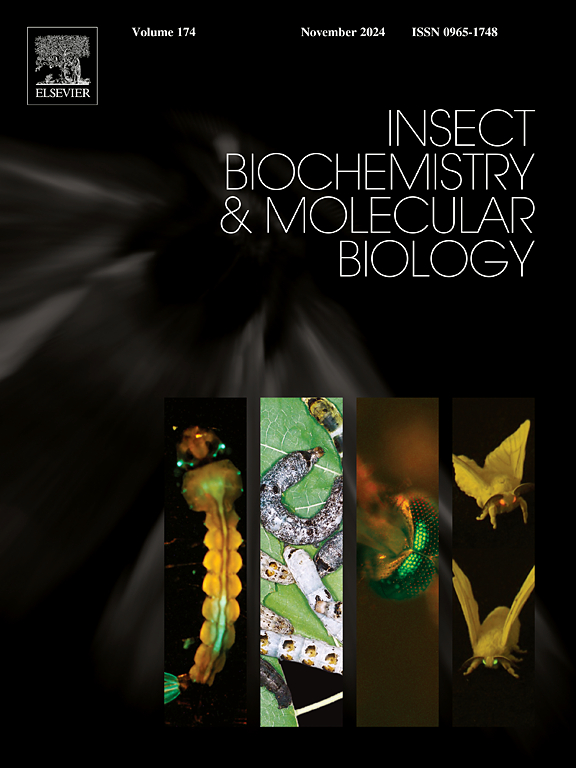BarH1 regulates the expression of conserved odorant-binding protein 22 from Dastarcus helophoroides
IF 3.2
2区 农林科学
Q2 BIOCHEMISTRY & MOLECULAR BIOLOGY
引用次数: 0
Abstract
Chemical signals are pivotal in establishing tritrophic interactions among host plants, herbivorous insects, and natural enemies. Previous studies have shown that evolutionarily conserved MaltOBPs in Monochamus alternatus and DhelOBPs in Dastarcus helophoroides contribute to the establishment of pine -pest - natural enemy tritrophic interactions by recognizing the same volatile emitted by the host during crucial developmental stages. We hypothesized that the transcriptional regulatory mechanisms of evolutionarily conserved OBPs respectively from pests and enemies are similar. In this study, we identified the promoter region of DhelOBP22 through chromosome walking and discovered that transcription factor BarH1, which have been proved to regulate the expression of MaltOBP19 in M. alternatus, regulates the expression of DhelOBP22 by binding to its promoter region, as evidenced by dual-luciferase assays and electrophoretic mobility shift assay (EMSA). When the BarH1 gene was silenced using RNAi, the expression of DhelOBP22 was inhibited, leading to the disappearance of the attracted behavior of mated female D. helophoroides adults towards camphene. This study underscores that conserved transcriptional regulation mechanisms play a role in regulating the expression of evolutionarily conserved OBPs respectively from herbivores and natural enemies.

BarH1调控了保守的气味结合蛋白22的表达。
化学信号是建立寄主植物、食草昆虫和天敌之间的营养相互作用的关键。先前的研究表明,在进化上保守的MaltOBPs (Monochamus alternatus)和DhelOBPs (Dastarcus helophoroides)通过识别宿主在关键发育阶段释放的相同挥发性物质,促进了松-害虫-天敌三营养相互作用的建立。我们假设,进化上保守的害虫和敌人OBPs的转录调控机制是相似的。在本研究中,我们通过染色体行走鉴定了DhelOBP22的启动子区域,并通过双荧光素酶测定和电泳迁移转移测定(EMSA)发现,转录因子BarH1通过结合DhelOBP22的启动子区域来调节DhelOBP22的表达,而转录因子BarH1已被证明可以调节M. alternatus中MaltOBP19的表达。利用RNAi沉默BarH1基因后,DhelOBP22的表达被抑制,导致雄性成虫对樟烯的吸引行为消失。本研究表明,保守的转录调控机制分别调控食草动物和天敌进化上保守的obp的表达。
本文章由计算机程序翻译,如有差异,请以英文原文为准。
求助全文
约1分钟内获得全文
求助全文
来源期刊
CiteScore
7.40
自引率
5.30%
发文量
105
审稿时长
40 days
期刊介绍:
This international journal publishes original contributions and mini-reviews in the fields of insect biochemistry and insect molecular biology. Main areas of interest are neurochemistry, hormone and pheromone biochemistry, enzymes and metabolism, hormone action and gene regulation, gene characterization and structure, pharmacology, immunology and cell and tissue culture. Papers on the biochemistry and molecular biology of other groups of arthropods are published if of general interest to the readership. Technique papers will be considered for publication if they significantly advance the field of insect biochemistry and molecular biology in the opinion of the Editors and Editorial Board.

 求助内容:
求助内容: 应助结果提醒方式:
应助结果提醒方式:


